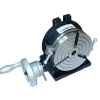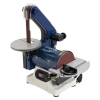Rotary Table ComparisonWe provide rotary table
instructions and dividing plate instructions (see table below).
We sell two quality levels of rotary tables. As you can see in the table above, the better quality rotary tables have lower values for flatness, parallelism, and squareness. (Note that the values for part numbers 1727 and 1927 are identical; these tables are identical except for the brand.) The values for even the less expensive rotary tables are pretty good. Another manifestation of the quality of a rotary table—how well you can adjust the backlash—is not listed in the table because we don't have precise numbers to compare. Rotary tables use a worm drive to turn the table. There must be play between the worm and the worm wheel or you cannot turn the table. But excessive play is exhibited as backlash-free turning of the hand wheel without the table turning. The amount of play is adjustable on all of our rotary tables. But if the worm wheel does not turn true, the backlash will vary with the rotation of the table. This variation cannot be adjusted out. Our more expensive rotary tables provide better (more consistent with rotation) backlash adjustment. Note that this adjustment is more critical for CNC applications. Only you can decide if the additional quality is worth the extra cost. We sell about 5 of the inexpensive rotary tables for each of the more expensive rotary tables we sell, and we get very few returns.
|




 Belt & Disk Sander, 1" x 30" Belt & 5" Disc
Belt & Disk Sander, 1" x 30" Belt & 5" Disc Tool Bit, 5/16" x 2-1/2", M2 HSS
Tool Bit, 5/16" x 2-1/2", M2 HSS
